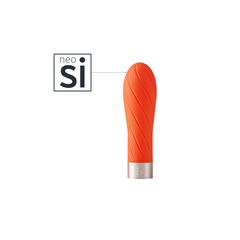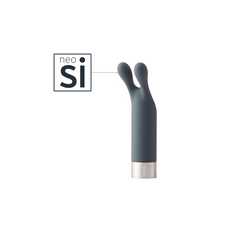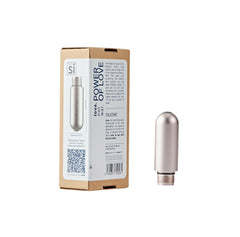love. not war is a sex positive brand, and we believe that your bedroom desires are something that should be openly discussed and explored without judgement. Whether it’s with a hot new hook-up or a long term partner, discussing what you enjoy in the bedroom and exploring new things should always be actively encouraged.
You may have heard of BDSM before, and wondered what exactly it is, and whether it’s for you. Exploring BDSM in a fun and safe way is becoming a part of frank discussions about sex and sexuality. Throughout this article, we discuss what BDSM is, and how you can introduce it into the bedroom.

So, what is BDSM?
BDSM is short for ‘Bondage, Discipline, Sadism and Masochism’. Each of these different dynamics explore the sensation to create a physical or psychological response on the participant(s).
Usually, BDSM involves a dominant person (dom) and a submissive person (sub) engaged in acts of play, but there is no ‘one-size fits all' when it comes to domination and submission. Depending on what you’re into can depend on the type of person you look for as a dominant or submissive - with some people wanting a strict, punishing dominant or a docile submissive or others wanting a ‘bratty’ sub and a more sensual dominant.
In pop culture, BDSM tends to be represented as purely inflicting pain on one of the participants. However, pain-play is only one small part of the community. BDSM play can encompass everything from being tied-up, light spanking and sensation play like wax dripping or even tickling with feathers to more hard-core or intense forms of sensation play including golden showers, pain-play and even humiliation & degradation! The spectrum of BDSM and the acts within vary and depend on the wants and desires of the participant.
Introducing BDSM into the bedroom
Just like introducing sex toys into the bedroom, BDSM is something that requires open and honest conversation between you and your partner(s). Because of the nature of BDSM, it can be intense and seemingly intimidating, so having an open dialogue is key to ensuring that everything goes right, and enthusiastic consent is given throughout!
Communication and Negotiation
Whether you’re engaging in a one-off or casual exploration of your kinks and fetishes, trying something new for the first time or you have joined a BDSM community and ascribe to the lifestyle, all practitioners of BDSM will explain that clear communication, consent, and negotiation are key to BDSM. Telling your partner about your expectations and limits, the type of relationship you want with your partner and what you want from a particular scene are all a part of planning a BDSM scene.
Discussions on your kinks, fetishes and boundaries are needed as people don’t always enjoy the same things or to the same levels of intensity and you need to respect, acknowledge, and adhere to this. When talking about trying out BDSM for the first time, along with negotiating your list of things you want to try and what will be a hard pass, having a safe word is also key. A safe-word or safe-signal if your mouth is covered is a way to stop a scene completely. It’s a way to say stop or no, especially when those words are part of your fantasy or roleplay. For those instances, especially when first trying BDSM play, that you’re looking for a way to check in the traffic light system is a great, intuitive way to check in throughout the scene and ensure that boundaries are being met and you haven’t moved past someone's limits.
Plan a scene together
Now that you have both consented to trying a BDSM scene, planning a scene is the next step. Make a list of what you both want to try, the roles you want to play and any limits you have; do you like dirty talk? What about being tied up? Do you like being blindfolded? Even for the dominant acting partner you may find that there are limits to what they are comfortable doing to a submissive. Negotiation is key for planning a BDSM scene out as you create a safe space for both of you to explore your kinks together. Not only does communication put you both in a healthy mindset, it fosters trust and develops intimacy as you build up your excitement.
As a beginner or an expert trying something new, it is best not to go too intense, even if you have both consented to spanking, using an open hand that you can easily control the level of impact on is a great place to start rather than using a flogger or whip. This allows you to both get used to and learn not just each other’s limits and boundaries but also how to do it safely.
Planning a BDSM scene will look different for each person depending on what they expect from a scene, what they want to try and the level of intensity. Another thing to remember with planning a BDSM scene is that it doesn’t have to just be about sex or orgasms but can be about creating intimacy between you and your partner.
Aftercare
Aftercare should also be a huge part of planning any scene, discussions on everything from cleaning up to physical touch afterwards should be discussed and what you will need should be on hand before you start a scene. From soft blankets and cuddling to medication, water, and food no matter how intense the scene was.
Aftercare allows you to leave the mindset of the BDSM scene you planned and reconnect and check in with each other. During this time, communicate your thoughts with your partner, discuss what went well, what you liked and what you didn’t like or want to try again.
Even if it was your fantasy being explored you are allowed to dislike it and change your mind about wanting to try it again. For the dominant partner it is also a great way to check in with your submissive partner that you both enjoyed what happened, and that they are not in pain or uncomfortable but also for you to check in with yourself and that you enjoyed it, especially for more intense, painful, or humiliating scenes.

Safety is Key
When planning a scene, safety is key. Below are some tips to keep your scenes safe and fun for all partners:
Avoid stimulants like drugs or alcohol before you play so that neither of you become inebriated and you can focus on each other and be able to quickly recognise any signs of discomfort.
- Make sure that any lubricants used are water based, especially when using silicone toys and that all toys are cleaned.
- When using handcuffs or restraints make sure they are not cutting off circulation and are easy to get out of. If your partner says that they have lost circulation, then immediately loosen the restraints
- When using wax, make sure you get wax-play specific candles so that the hot wax doesn’t burn your partner
- If you are trying impact play, especially with whips and paddles, focus on the fleshy areas of the body to avoid damaging your partner.
- Any form of restraint over the head, check in regularly to make sure that your partner is not overheating or unable to breathe.
As well as physical safety, mentally being safe is also a must, as said earlier through the traffic light system you can check in with partners to make sure you haven’t overstepped boundaries and limits, especially when trying something for the first time or when working towards overcoming a limit. All people experience triggers, and this can happen out of nowhere, so it’s important to make sure that you are not triggering your partner during a scene.
BDSM can allow you to develop a better understanding of your wants and fantasies as well as act them out in a safe way with someone that you trust to create a deeper sense of intimacy between you and your partner.
Written by Katrina Fairhurst



























